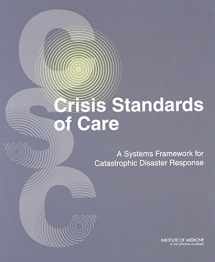
Crisis Standards of Care: A Systems Framework for Catastrophic Disaster Response: Volume 1: Introduction and CSC Framework
Book details
Summary
Description
Catastrophic disasters occurring in 2011 in the United States and worldwide--from the tornado in Joplin, Missouri, to the earthquake and tsunami in Japan, to the earthquake in New Zealand--have demonstrated that even prepared communities can be overwhelmed. In 2009, at the height of the influenza A (H1N1) pandemic, the Assistant Secretary for Preparedness and Response at the Department of Health and Human Services, along with the Department of Veterans Affairs and the National Highway Traffic Safety Administration, asked the Institute of Medicine (IOM) to convene a committee of experts to develop national guidance for use by state and local public health officials and health-sector agencies and institutions in establishing and implementing standards of care that should apply in disaster situations-both naturally occurring and man-made-under conditions of scarce resources.
Building on the work of phase one (which is described in IOM's 2009 letter report, Guidance for Establishing Crisis Standards of Care for Use in Disaster Situations), the committee developed detailed templates enumerating the functions and tasks of the key stakeholder groups involved in crisis standards of care (CSC) planning, implementation, and public engagement-state and local governments, emergency medical services (EMS), hospitals and acute care facilities, and out-of-hospital and alternate care systems. Crisis Standards of Care provides a framework for a systems approach to the development and implementation of CSC plans, and addresses the legal issues and the ethical, palliative care, and mental health issues that agencies and organizations at each level of a disaster response should address. Please note: this report is not intended to be a detailed guide to emergency preparedness or disaster response. What is described in this report is an extrapolation of existing incident management practices and principles.
Crisis Standards of Care is a seven-volume set: Volume 1 provides an overview; Volume 2 pertains to state and local governments; Volume 3 pertains to emergency medical services; Volume 4 pertains to hospitals and acute care facilities; Volume 5 pertains to out-of-hospital care and alternate care systems; Volume 6 contains a public engagement toolkit; and Volume 7 contains appendixes with additional resources.
Table of Contents- Front Matter
- Volume 1--Introduction and CSC Framework
- Volume 2--State and Local Government
- Volume 3--EMS
- Volume 4--Hospital
- Volume 5--Alternate Care Systems
- Volume 6--Public Engagement
- Volume 7--Appendixes


We would LOVE it if you could help us and other readers by reviewing the book
Book review



